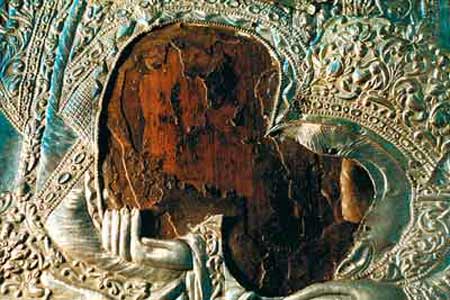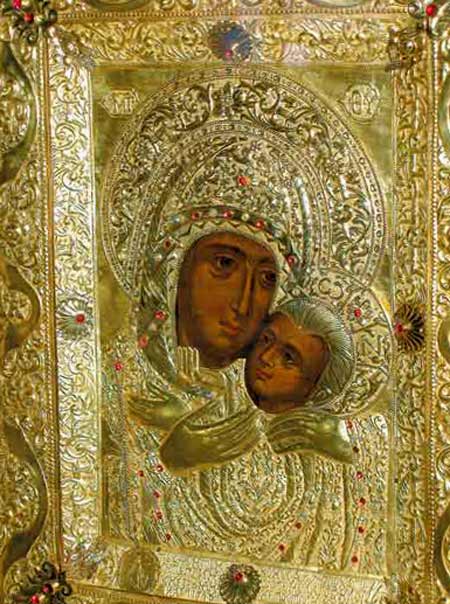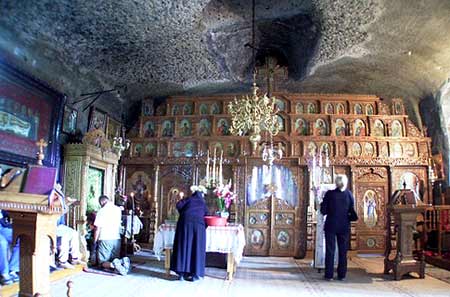 Is one of the most peaceful and spiritual place for the whole Christianity because here, according to the legend, is sheltered one of the most valuable icons representing the Holy Mother and Jesus as a Child, painted by Saint Luca – the Evangelist and brought on these places by Andrew, the first called of the Jesus Apostles. But the monastery is also valuable itself being located in a rock carved in ancient times, and there are not known the exact dates when the church was founded. It is told that the church was founded in a Christian catacomb from the roman period. The tradition associates the beginnings of the monastery with the discovery in a cave of a Virgin Mary miracle worker icon (one of the 12 wooden icons with the real face of Virgin Mary painted by the Saint Luca for each of the 12 apostles) during the Negru Voda reign.
Is one of the most peaceful and spiritual place for the whole Christianity because here, according to the legend, is sheltered one of the most valuable icons representing the Holy Mother and Jesus as a Child, painted by Saint Luca – the Evangelist and brought on these places by Andrew, the first called of the Jesus Apostles. But the monastery is also valuable itself being located in a rock carved in ancient times, and there are not known the exact dates when the church was founded. It is told that the church was founded in a Christian catacomb from the roman period. The tradition associates the beginnings of the monastery with the discovery in a cave of a Virgin Mary miracle worker icon (one of the 12 wooden icons with the real face of Virgin Mary painted by the Saint Luca for each of the 12 apostles) during the Negru Voda reign.
 The first written document about the monastery are from 1386 when Dracula’s grandfather, king Mircea the Old, was giving to the nearby village this nun monastery. Other written documents are from 1503 – 1547 from kings Radu the Great and Mircea the Shepherd. According to the legend, a shepherd arrived with his sheep in these places and he made a stop overnight at the base of the mountain near the forest on a big rock. In his dreams the Virgin Mary told the shepherd to search in the rock and he will find a cave, and inside the cave will be a holy icon. In that cave he was told to establish a monastery. The shepherd started to dig in the rock and after several days he discovered the entrance to the cave and inside he found the holy icon.
The first written document about the monastery are from 1386 when Dracula’s grandfather, king Mircea the Old, was giving to the nearby village this nun monastery. Other written documents are from 1503 – 1547 from kings Radu the Great and Mircea the Shepherd. According to the legend, a shepherd arrived with his sheep in these places and he made a stop overnight at the base of the mountain near the forest on a big rock. In his dreams the Virgin Mary told the shepherd to search in the rock and he will find a cave, and inside the cave will be a holy icon. In that cave he was told to establish a monastery. The shepherd started to dig in the rock and after several days he discovered the entrance to the cave and inside he found the holy icon.
The legend also says that Andrew the apostle chased by the roman soldiers, was hiding here in this cave carrying the holy icon with him. Andrew is the Saint patron of Romania because he is considered to be the one who started the Christianity in these places of Europe. When Andrew found the cave he thought inside is a priest of a god who has a shrine inside the cave. So he and his companions got down inside the cave and when they found no one inside Andrew told the others “NEMO EST” meaning “nobody here” in latin. So the name remained for the monastery and for the village around.
Miracles are coming as a reward to the strong faith

In 1798, the icon was covered in silver by Enache the Seneschal, and in 1913, the wife of a general from the Romanian army asked to make a silver frame for the icon. It is told that when the fire started here during the bombardments from the first world war, came near the icon, it was suddenly extinguished. The holy icon was in a process of complete restoration process and become famous for many miracles that happened with women who came to pray for having children or to be cured of severe affections. The icon that become very deteriorated, had to be restored because according to the Orthodox Church, when an icon is deteriorated badly, it had to be restored or burned on fire. Saint John Damaschin says in the 2nd Treaty – Apologetic “I do not pray to the wood, because when the cross shape is destroyed I am burning the wood, ald also the icons”. The restoration of the icon was done using a method from the Athos mountains, used since the 16th century for the icon of Virgin Mary from Vatoped Monastery where the monks painted a silk with the same colors and similar with the original. Then the silk was put over the icon letting the wood untouched and also the remains of the old painting.
A triangle of Christianity
All the time, the monastery, with the dedication days: “The Holy Virgin’s Entering the Church”, 21 November, and “The Curing Spring”, the first Friday after Easter, had a number of 33 nuns, like the number of Christ years when was crucified. Together with the Namaiesti Monastery, there are two other such holy places, that are forming a triangle: Corbii de Piatră and Cetăţuia of Negru Vodă. These holy places are also cave churches, located not far away of Câmpulung Muscel, former capital of Wallachia.

